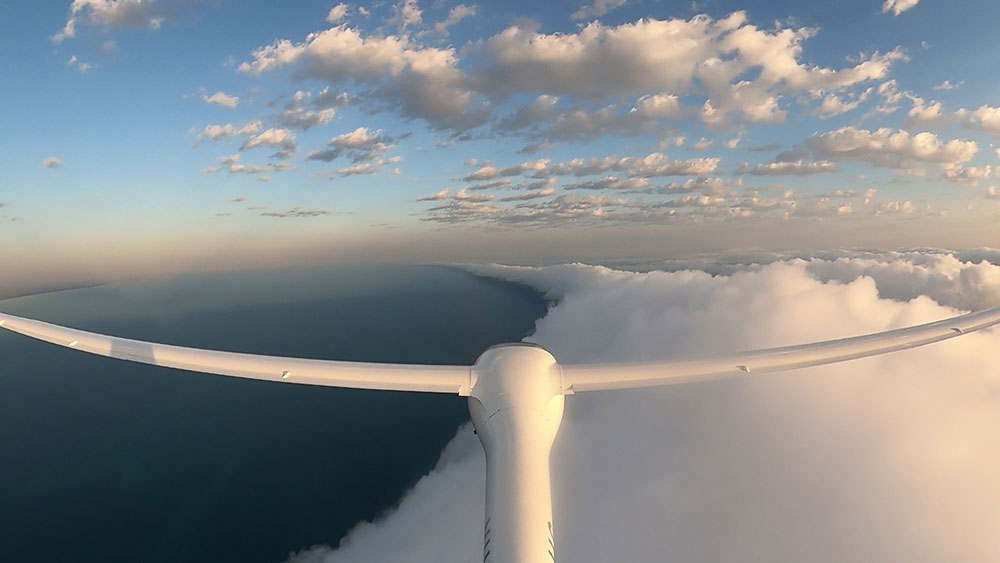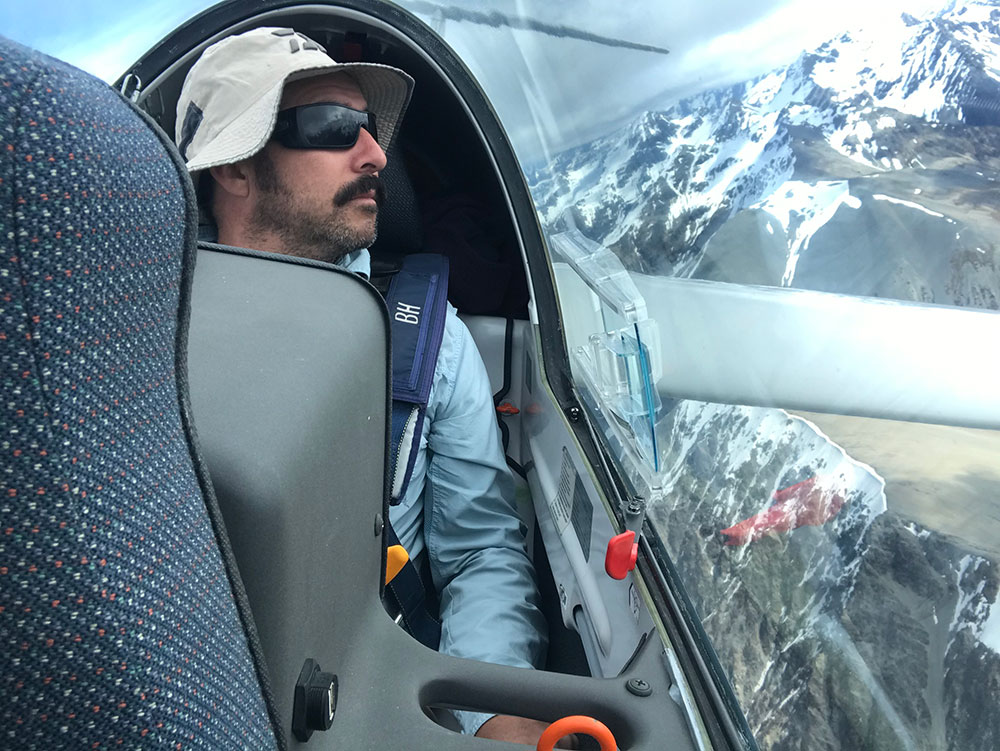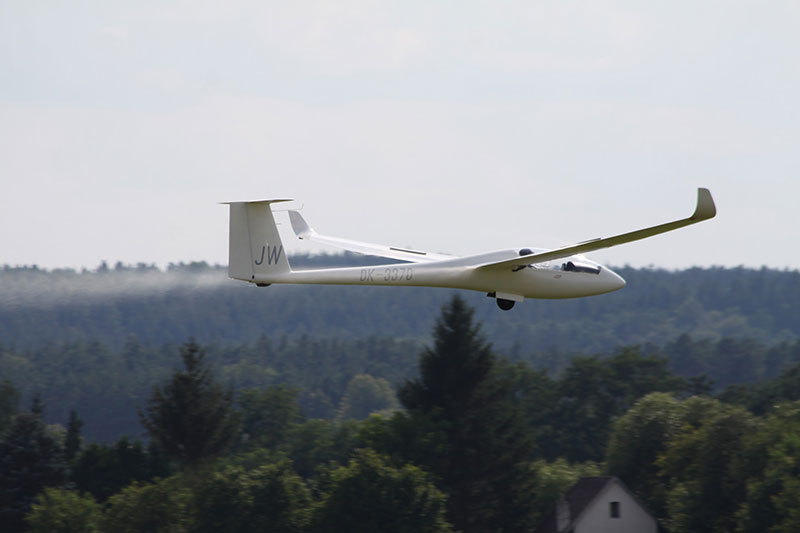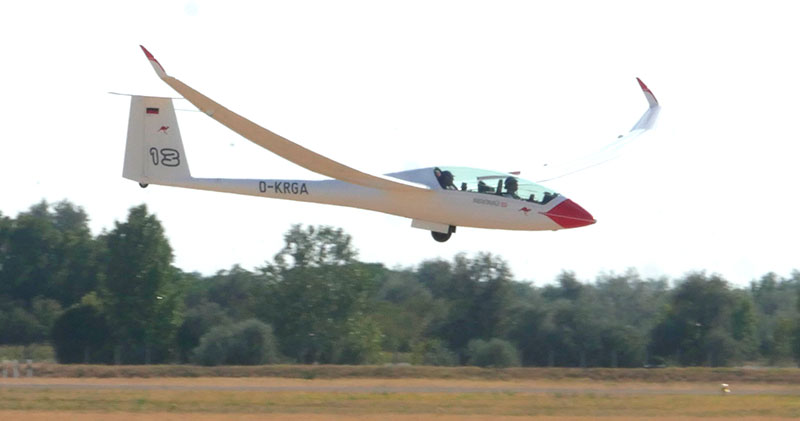By Bernard Eckey
In the previous five articles we have already looked at various proven methods of working on our mindset in order to improve our rate of success and enhance our enjoyment. Today we will expand on this topic and deal with decision-making as well as concentration.
Decision-making and observations
Everything we do as glider pilots must be done for a reason – otherwise we rely on good fortune rather than good management. Without fail, careful decision-making makes the difference between sweet success and bitter disappointment. However, in gliding the choices are seldom clear, which dictates that benefits and likely consequences are weighed up carefully.
Top glider pilots are switched-on and continually engage in gathering information! The reason is simple and doesn’t need much elaboration. If we don’t want to rely on good luck, our decision-making must be underpinned by observations and a careful evaluation of all available information. The more information we gather the easier it gets to evaluate the pros and cons and the better our chances of getting it right. The next step is a prompt implementation of our decisions. Procrastination must never be allowed to get the upper hand in gliding.
The advantages of information gathering extend to the subconscious level. It is often said that truly great pilots fly intuitively and just know what to do next. Far from being exceptionally talented, these pilots pair their experience with their mental storage of hundreds of seemingly insignificant observations. This allows their brains a subconscious evaluation of all these inputs and a lightning fast implementation. Put differently, their intuition or their ‘gut feeling’ takes over.
Pilot’s Intuition
Heavily relying on intuition when rational thinking doesn’t dictate a clear path of action is a trademark of thriving people and it is particularly common among successful glider pilots. Even the greatest minds of all times freely admit that intuition accompanied rational thinking in some of history’s greatest discoveries or breakthroughs. Be careful though – never let intuition overrule facts and logical thinking, and don’t confuse intuition with impulse. Decisions taken in haste often stem from anger due to a lack of alternatives.
How does all of this apply to a newcomer preparing for local soaring? Observing a few launches and closely watching other gliders, rising dust, smoke or soaring birds is just as much part of the observation process as noticing areas of lift or strong sink. Indications like these are vital and must be memorised. The windsock, the nearby vegetation and the surrounding topography provide equally important clues – especially if the wind direction has a strong effect on local sources of lift and known thermal triggers. Every clue is taken into account and that includes drawing on past experience and local knowledge.
In Competition
Decision making in a competitive environment takes on a totally different meaning. Observations must become much broader and this includes an assessment of flying conditions at least as far as 50km ahead. Only a constant evaluation of weather and terrain allows a change of flying tactics if and when necessary. This includes an assessment of flying conditions on the next leg well before arriving at a turn point, and an early look at the clouds along the intended track is an integral part of this process.
Fact-finding extends to pilot briefings as well, and weather briefings in particular. At high-level competitions, the interpretation of weather data is often left to the pilot. A detailed study of synoptic charts with an independent assessment of possible changes to soaring conditions during the day should therefore become part of every competition pilot’s flight preparation.
A frequent reassessment of our in-flight decisions is just as vital. Here are a few examples for the thermalling part of a flight:
• Adjust the angle of bank
• Correct nose/horizon attitude
• Use more (or less) rudder
• Adjust airspeed
• Check flap setting (if applicable)
• Re-evaluate thermal strength
• Decide when to leave the thermal
Reassessing Assessments
Pilots need to continually evaluate whether previous actions have proven successful or not. The winner of a competition day (or the whole contest for that matter) is usually the pilot who spends the least amount of time circling. In other words, neglecting to reassess previous decisions at short intervals is likely to leave us behind.
For the cruising part of the flight, the list would include such things as:
• Heading changes for a better extraction of atmospheric energy
• Circumnavigating areas of overdevelopment
• Speed adjustments in areas of lift or sink
• Detours to sample areas marked by soaring birds
• Bypassing irrigation areas
• Cruise speed variations in view of changing conditions ahead
Of course, we can’t expect all our decisions to be correct, but if we want to improve as pilots we had better keep working on this. Smart decisions usually make the difference between success and failure. Lady Luck may favour us on occasions, but have you ever noticed that the same pilots usually have all the luck? The more decisions they make and the more observations they evaluate, the better their chances of getting things right – and the luckier they get!
Decision Fatigue
Now to the downside of decision-making. No matter how rational or high-minded we try to be, we can’t make decision after decision without paying a biological price. It is very different from ordinary physical fatigue where getting tired or becoming exhausted is easily recognised. However, getting low on mental energy is an insidious process and one we are not conscious of.
The more choices we make during the day the harder each one becomes. Our brain gets exhausted and will look for shortcuts, one of which is to act impulsively instead of expending the energy of thinking through the consequences.
Another shortcut is the ultimate energy saver – doing nothing. Instead of agonising over decisions we avoid them, although it is well known that making no decision is the worst decision one can possibly make! This often creates bigger problems in the long run, but in the short term it eases the mental strain. There can be little doubt that this has been a contributing factor to some aviation mishaps in the past.
By now it should be abundantly clear that good decision-making is essential, regardless of whether we fly competitively or just engage in some relaxing Sunday afternoon local soaring.
Concentration
Concentration is the art of focussing on the right thing at the right time. The very safety of a flight depends to a large degree on the ability of the pilot to concentrate until the aircraft is back on the ground or, better still, back in the hangar. On some flights, we can’t relax for a single minute, while on others we can sit back and admire the view while at ease.
The necessary level of concentration also depends on whether we fly competitively or fly locally and just for the fun of it. This statement doesn’t imply disrespect for pilots conducting local soaring, but the fact remains that it requires nowhere near as much concentration as cross-country or competition flying.
Pilots who fly competitively know only too well that intense concentration for five or six hours a day over a two-week period is very hard work indeed. A proven method of avoiding excessive mental slackness is to keep one’s blood sugar levels up by eating small amounts of suitable food every two hours or so. But not just any food will do – the right food with high nutritional values is what matters when it comes to sustain an adequate amount of blood sugar in our system.
Sweet Dangers
Beware of simple carbohydrates such as sweets, chocolate and any sort of so-called ‘fast food’. They tend to elevate blood sugar levels rapidly and hence trigger insulin production. This promptly deals with the problem and rapidly reduces blood sugar concentration again. Just 10 to 15 minutes after eating these concentrated sugar treats we are left with much lower levels of blood sugar and we can be significantly worse off than before. The same warning applies to soft drinks, as they contain huge amounts of refined sugar, colouring agents and preservatives. Plain water, possibly mixed with some fruit juice, is much better.
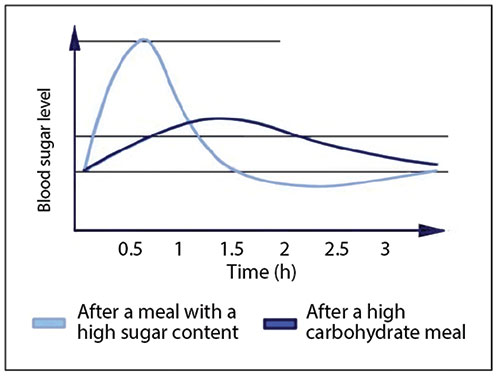
The above graphic clearly indicates that even during flights lasting for only three hours or so, it is highly advisable to eat something. My preference is for fruit containing fructose, such as apples, sultanas or bananas. Sure, that is nothing more than sugar in another form but, compared to refined sugar, the body takes far longer to absorb it. The net result is a more even release of brain food and an extended period of effectiveness.
On long to very long flights, it is imperative to complement this with an additional high carbohydrate intake, such as a sandwich or two. Otherwise we are at risk of making very poor decisions towards the end of the flight. No doubt there are plenty of aviation mishaps where low blood sugar levels played a significant role.
Concentration vs Pressure
The necessary level of concentration also depends very much on the different stages of the flight. Apart from take-off and landing, our utmost concentration is required when we are getting low and therefore we must learn to adjust our concentration level to meet specific situations.
Of course, maintaining a top level of concentration is impossible over a long period or over the entire duration of the flight. After a good climb to a comfortable altitude, for example, we can and should relax a little. Now is the time for a drink, to eat an apple or take a bite or two of a sandwich. In other words, especially during long duration flights, it is important to pace ourselves and regulate concentration and arousal levels.
Even highly experienced pilots can buckle under pressure and lose concentration under competition stress. Certainly, pressure is an integral part of competition flying but when it leads to poor concentration and decision-making, it is very easy to confuse bad luck with bad judgement. How stress and our own performance expectations affect concentration will be the subject of the next article. Please remain tuned to this channel.




























